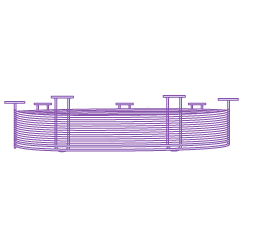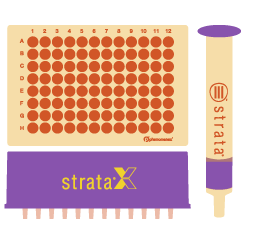NEW
Chromatography Tips
Digital Library
This digital library will be updated with a new tip monthly.

Need product, method and quote support? We've got you covered! Request Support Now →

LC TIPS
Fundamental
- The importance of a well-prepared mobile phase →
- The effects of gradient on buffer capacity →
- How can capacity factors drive method robustness? →
- The role of end-capping in RP →
- Overcoming Peak Tailing of Basic Analytes in Silica Type A Stationary Phases in RP →
- Basic analytes and the benefits of modified silica supports in reversed-phase LC →
- Basic Analytes and the Use of High pH Stable Stationary Phases →
- Scaling Analytical Methods to Preparative Chromatography - Part 1 →
- Scaling Analytical Methods to Preparative Chromatography - Part 2 →
- 📹 Video-Tip - My Column Looks Like It Is Shipped in Hexane, but I Need to Use It in Water and Acetonitrile. How Do I Switch the Solvents in the Column? →
- 📹 Video-Tip - How Can I Extend the Lifetime of My SEC Column? →
- 📹Video-Tip - HILIC explained in one minute →
Method Development
- A systematic approach to chiral screening and method development →
- Advantages of using immobilized stationary phases in chiral separations →
- A Systematic Approach to Peptide Analysis →
- Method Development Strategies for Oligonucleotides →
- The Use of Bio-Inert Hardware in the Analysis of Oligonucleotides →
- 📹 Video-Tip - How to Select the Right C18 Chemistry for My Peptide Mapping Analysis →
Troubleshooting
- Column contamination – what is happening, and how it can be avoided →
- The danger of mobile phase mismatch →
- LC System Optimization for UHPLC Performance on any HPLC →
- 📹 Video-Tip - I’m having problems with my peak’s retention time moving but don’t know where to start troubleshooting →

GC TIPS
Fundamental
- Pre-installation checklist and how to install new GC column →
- Gas Chromatography Column Installation - Detector Installation →
- Gas Chromatography (GC) Column Conditioning, Testing and Checks →
- 📹 Video-Tip - I am struggling to figure out what dimension of column I need for my GC method. Can you please help? →
- How Hot is TOO Hot? - Part 1 →
- 📹 Video-Tip - Do I Really Need to Keep Trimming My GC Column? →
- How Hot is TOO Hot? - Part 2 →
- Sample Injection Techniques: Enhancing Efficiency in Chromatographic Analysis →
- The Inlet: Setting a Maintenance Schedule →
- How to Protect Your GC Column - Part 1 →
- How to Protect Your GC Column - Part 2 →
Method Development
- What parameters should I consider when selecting a GC column for my application? →
- GC Column Selection by Column Dimension →
- Good column selection: Polarity vs Selectivity →
- Retention Times Prolonged or Shortened →
- Using Phase Ratio to Reduce Run Time →
Troubleshooting
- Peak Shape Problems: Tailing Peaks →
- Peak Shape Problems: Sensitivity Loss →
- Peak Shape Problems: Broad solvent Peaks/fronts →
- Peak Shape Problems: Negative Peaks. Some or All Peaks Dip Below the Baseline →
- Peak Shape Problems: No Peaks →
- Baseline problems - offset →

SAMPLE PREP TIPS
Fundamental
- Generic SPE Method by Retention Mechanism →
- How is normal phase SPE different from reversed phase SPE? How do I decide which one to use? →
- How much sample can I load onto my SPE device? Is it linked to the concentration of my analyte of interest? →
- 📹 Video-Tip - Are You Using the Right SPE Wash Step? →
- What is the Matrix Effect? →
- Why Is It Necessary to Dry the SPE Sorbent Before Elution? →
Application
- Considerations when working with solid samples and SPE →
- Sample Pre-treatment Procedures for Bioanalytical Samples →
- Peptide Mapping Sample Prep - Good Practices for Tryptic Digests →
- Sample prep for N-linked Glycans - The use of a sample prep plate for cleaning up N-linked glycans cleaved from glycoproteins →
- Sample Preparation for Oligonucleotides →
- All My Analytes are Neutrals, but Contaminants are Acids or Amines. What is the Best Way to Concentrate and Clean Up my Analytes of Interest? →
- Why Remove Phospholipids From a Sample? →
- 📹 Video-Tip - How to improve my oligonucleotide conjugate recovery with Clarity OTX Pro →
Troubleshooting
- Over-Drying of Silica-Based SPE Cartridges Can Lead to Poor Sample Recovery →
- Troubleshooting SPE →
- I am getting low recovery in my SPE method, how do I fix the problem? →
- 📹 Video-Tip - My recovery is lower than expected after my SPE method. Why and how can I fix it? →
- Why are my recoveries greater than 100%? →
- 📹 Video-Tip - My Sample Won’t Flow Through My SPE Cartridge, Why Is This Happening? →
- SPE Troubleshooting - Extra Peak →


